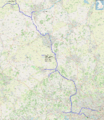Grand Junction Canal facts for kids
The Grand Junction Canal is a famous canal in England. It connects Braunston in Northamptonshire to the River Thames at Brentford. This important waterway was built between 1793 and 1805. Its main purpose was to create a better route from the Midlands to London. It helped boats avoid the difficult upper parts of the River Thames near Oxford. This made journeys much shorter and more reliable.
In 1927, the Regent's Canal Company bought the canal. Since January 1, 1929, it has been the southern part of the Grand Union Main Line. This main line runs all the way from London to Birmingham. Today, many people use the canal for fun activities like boating.
A famous engineer named Isambard Kingdom Brunel built his last major project on this canal. It's called Three Bridges, London. Work on these unique bridges started in 1856 and finished in 1859. The three bridges cross over each other. They allow the Grand Junction Canal, the Great Western and Brentford Railway, and Windmill Lane to all pass through the same spot.
Contents
History of the Grand Junction Canal
Why the Canal Was Needed
By 1790, many canals were already built or being built in the Midlands. But getting goods to London was still hard. The only way was to use the Oxford Canal to Oxford. From there, boats had to go down the River Thames to the capital.
The river, especially its upper parts, was not good for boats. It had shallow sections and not enough water. This caused delays at locks. Also, there were often arguments with mill owners about water supplies. People needed a better way to move goods.
In 1791 and 1792, engineers surveyed a new route. They looked at a path from Brentford on the Thames to Braunston on the Oxford Canal. Other ideas for a direct route to London were also suggested. But on April 30, 1793, Parliament approved the plan for the Grand Junction Canal.
Building the Canal
The law passed by Parliament allowed the company to raise money. They could raise up to £600,000 to build the main canal line. Construction started almost right away from both ends. William Jessop was put in charge of the building work. An engineer named James Barnes was hired on June 3, 1793.
Building the Blisworth Tunnel was very difficult. Workers found quicksand, and there were mistakes in lining up the tunnel. This made the tunnel have a noticeable bend. In June 1796, the canal opened from the Oxford Canal to Weedon Bec. This was after the Braunston Tunnel was finished. But Blisworth Tunnel kept causing problems. It even collapsed in January 1796.
The canal from Braunston to Blisworth opened in 1797. By 1798, the canal from the Thames reached Two Waters near Hemel Hempstead. It reached Bulbourne in 1799. This was at the north end of the Tring summit. In 1800, it reached Stoke Bruerne at the south end of Blisworth Tunnel.
So, by 1800, most of the main canal line was open. Only the Blisworth Tunnel was not finished. To move goods across the gap, a road was built over Blisworth hill. Later, a tramway was built over the hill by Benjamin Outram.
Work on the tunnel started again in June 1802 on a new path. It was finally finished in March 1805.
Another challenge was crossing the River Great Ouse at Wolverton. At first, nine temporary locks were used. In 1799, William Jessop designed a stone aqueduct to cross the river. But it collapsed in 1808. A temporary wooden trough was used. Then, it was decided to build an iron aqueduct. Benjamin Bevan was the engineer for this project. The new aqueduct opened on January 22, 1811.
The Grand Junction Canal made a huge difference. It cut the distance to London from the Midlands by 60 miles. This was compared to the old route via Oxford and the River Thames. It also made the journey much more reliable. The canal was very successful. In 1810, it carried 343,560 tons of goods through London.
The Canal Branches
The Grand Junction Canal also had several branches. These were smaller canals that connected to the main line. The original plan in 1793 allowed for branches to Daventry, the River Nene at Northampton, and to Old Stratford. The branches to Daventry and Watford were never built.
The branch to Northampton was delayed. It was eventually built as a 5-mile canal from Gayton. It opened in 1815. This connected to a tramroad that used to be at Blisworth Tunnel. Later, the Grand Union Canal provided a more direct link to Leicester.
In 1794, three more branches were approved. These were to Aylesbury, Buckingham, and Wendover. The 6.5-mile Wendover branch opened in 1799. It brought water to the canal's highest point at Tring. The 10.5-mile Buckingham branch opened in 1801. Both of these branches eventually stopped being used. However, the Wendover Arm is now being restored. The 6-mile Aylesbury branch opened in 1815. It was planned to connect to other canals, but this never happened.
In April 1795, a 13.5-mile branch to Paddington was approved. This branch started near Hayes. It was finished in 1801. This branch became very important for trade. It had a large basin at Paddington and many wharfs. It became even more important when the Regent's Canal opened later. This branch also supplied water from the River Brent.
The last branch to be built was the 5-mile route to Slough. It opened in 1882.
Images for kids
-
Top lock at Stoke Bruerne



